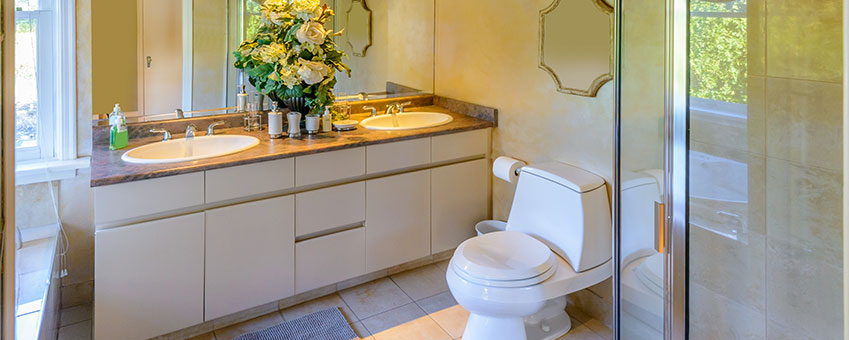Lighting plays a pivotal role in bathroom design, often being the unsung hero that ties the space together. It’s not just about choosing stylish fixtures—it’s about functionality, safety, and ambiance. Unfortunately, many homeowners fall into the trap of making common bathroom lighting mistakes, which can negatively affect the overall look and usability of the space.
In this comprehensive guide, we’ll break down the most common mistakes and provide practical, step-by-step solutions to help you avoid them.
Common Bathroom Lighting Mistakes and How to Avoid Them
Mistake #1 – Insufficient Bathroom Lighting
One of the most prevalent bathroom lighting mistakes is insufficient illumination. Poor lighting impacts functionality, especially during grooming and makeup application. Shadows and dim spots can make daily routines more difficult.
How to Fix It:
-
Assess Your Current Lighting: Identify dark corners and areas that lack proper visibility.
-
Determine Task Lighting Needs: Think about your daily routines and ensure lighting supports them.
-
Invest in Quality Fixtures: Use vanity lights or sconces that distribute light evenly and reduce shadows.
-
Balance Ambient and Task Lighting: Combine overhead lights with task lighting for an even glow.
Mistake #2 – Incorrect Fixture Placement
Even the best fixtures won’t perform well if placed incorrectly. One of the most overlooked bathroom lighting mistakes is poor positioning that leads to harsh shadows or glare, particularly around the vanity.
How to Fix It:
-
Understand Fixture Placement: Proper placement improves both function and aesthetic.
-
Position at Eye Level: Install vanity lighting on both sides of the mirror, not just above.
-
Use Multiple Lighting Zones: Include ambient, task, and accent lighting.
-
Consult a Pro if Needed: Lighting designers can help optimize fixture placement based on your space.
Mistake #3 – Ignoring Task Lighting
Task lighting is often an afterthought, but neglecting it is one of the top bathroom lighting mistakes. Essential areas like vanities, showers, or reading zones deserve targeted lighting to enhance usability.
How to Fix It:
-
Identify Key Tasks: List activities that require dedicated light (e.g., shaving, makeup).
-
Install Task Fixtures: Use wall sconces, pendant lights, or recessed fixtures where needed.
-
Choose Adjustable Options: Fixtures with dimmers or movable arms offer customization.
-
Layer Your Lighting: A combination of ambient, task, and accent lighting adds depth and function.
Mistake #4 – Forgetting About Dimmer Controls
A common but avoidable mistake is overlooking dimmer switches. These small additions offer big benefits, making your bathroom both practical and mood-friendly.
How to Fix It:
-
Understand Dimming Functionality: Control the lighting intensity for different uses.
-
Add Dimmers to Key Fixtures: Use them on vanity lights or overhead fixtures for more flexibility.
-
Experiment with Ambiance: Bright for mornings, soft for evening soaks.
-
Save Energy: Dimming reduces electricity use and extends bulb lifespan.
Mistake #5 – Neglecting Ventilation in Lighting Plans
Moisture buildup from poor ventilation can damage your fixtures—a hidden yet serious bathroom lighting mistake. Mold, rust, and electrical hazards often result from this oversight.
How to Fix It:
-
Understand Why Ventilation Matters: Reduces moisture, odor, and potential fixture damage.
-
Choose the Right System: Exhaust fans and windows promote airflow.
-
Strategically Place Vents: Near showers and tubs to capture steam efficiently.
-
Maintain the System: Regular cleaning and filter replacements ensure peak performance.
FAQ: Quick Answers to Common Questions About Bathroom Lighting Mistakes
Q: How can I combat insufficient bathroom lighting?
A: Use task lighting like vanity lights or sconces to brighten shadowy areas and improve functionality.
Q: What is the correct placement for lighting fixtures?
A: Install lights at eye level on both sides of the mirror for even, shadow-free illumination.
Q: Why is task lighting so important in the bathroom?
A: It ensures every corner is well-lit for specific activities like grooming or reading.
Q: How do dimmer switches help?
A: They offer flexibility in brightness and ambiance, plus energy savings.
Q: Why is ventilation relevant to bathroom lighting?
A: Good ventilation prevents moisture damage to fixtures and extends their lifespan.
Say Goodbye to Bathroom Lighting Mistakes
Avoiding bathroom lighting mistakes can transform your space from frustrating to functional. With the right fixtures, placement, and planning, your bathroom can offer both beauty and efficiency. Pay attention to lighting just as much as you would tile, cabinetry, or paint—your future self will thank you.



